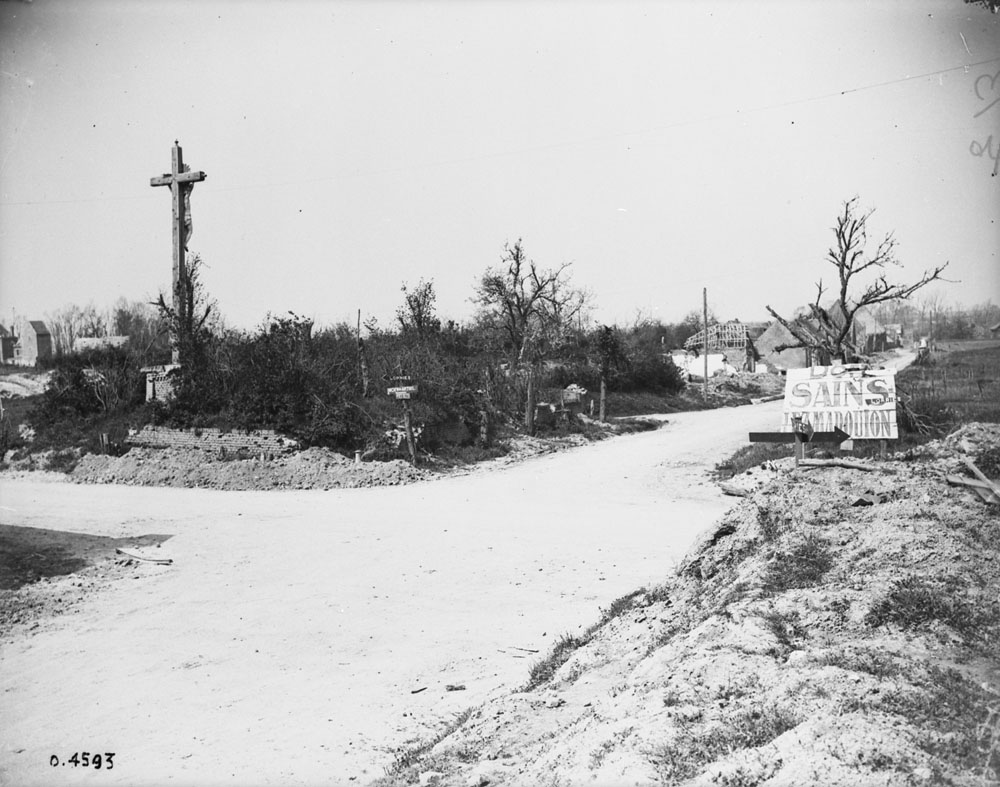Private Richard Bloor of the 50th Canadian Infantry Battalion, posthumously earned the Distinguished Conduct Medal. Only five days after his 41st birthday at the Battle of Canal du Nord. Richard resided at 488 Logan Ave, Trenton, New Jersey with his wife Gertrude Agnes Bloor, and came to Canada enlist in the CEF in September 1917.
Enlistment of Private Richard Bloor
Richard Bloor 3030643 born 12 May 1877 and enlisted 24 September 1917 at Toronto. Richard was 40 years, 5 months of age at the time, standing 5′ 8″ tall, 145 pounds with dark complexion, blue eyes and brown hair. He embarked Canada from Halifax on 3 February 1918, later arriving in Liverpool on 16 February 1918 with the 8th Reserve Battalion.

Private Richard Bloor completes his Will on 8 January 18 at 1st Depot Battalion, 2nd Central Ontario Regiment, West Sandling. Will’s usually completed in anticipation of proceeding overseas, but Richard does not do so until late summer. Finally, proceeded overseas for service with the 102nd Battalion, 18 August 1918.
102nd Battalion
Organized in November 1915 initially under the command of Lieutenant-Colonel J W Warden. Mobilized at Comox, and recruited in northern British Columbia. Embarked from Halifax 20 June 1916 aboard EMPRESS OF BRITAIN, and later disembarked in England 28 June 1916, with a strength of 37 officers, 968 other ranks. Disembarked in France 11 August 1916 as part of the 4th Canadian Division, 11th Canadian Infantry Brigade, and later reinforced by 16th Canadian Reserve Battalion. Perpetuated by The North British Columbia Regiment.

Private Bloor does not catch up with his intended unit, rather, Richard SoS to the 50th Battalion on 26 August 1918. He finds his unit in Gentelles Wood.
50th Battalion, Canadian Infantry (Alberta Regiment)
Organized in December 1914 initially under the command of Lieutenant-Colonel E G Mason. Mobilized at Calgary, and also recruited in Calgary. Drafts of 5 officers, 251 other ranks and also 5 officers, 250 other ranks sent to England on 14 June and 11 September 1915. Embarked from Halifax 27 October 1915 aboard ORDUNA, and later disembarked in England n 4 November 1915, with a strength of 41 officers, 1036 other ranks. Arrived in France 11 August 1916, with the 4th Canadian Division, 10th Canadian Infantry Brigade, and later reinforced by 21st Canadian Reserve Battalion.

Battle of Drocourt-Quéant Line (Wotan Stellung)
On 29 August 1918, south-east of Arras, the Commanding Officer of the 50th Battalion addressed all recent recruits, including Private Bloor at 17h30.
On 1 September 1918, all four companies of the 50th Battalion in position for the attack on the Drocourt-Queant Switch. New recruits eager for their first show. By the end of the next day, the brigade captures over 1,000 German prisoners. The 50th lose 2 officers, and 9 Other Ranks, in addition, over 180 wounded.
Battle of Canal du Nord
27 September 1918. On the left, troops of the Canadian Corps reach the Douai-Cambrai road and make its main objective, the Blue Line, by 14h00, in the face of a reawakened German resistance at Chapel Corner. On the Corps right, having advanced roughly four kilometers, Canadian troops held up just past Bourlon Wood.
At the end of the battle the British troops withdrawn from Bourlon, and the wood and the village ultimately retaken by the 3rd Canadian and 4th Canadian Divisions on 27 September 1918.
Quarry Wood
The cemetery (QUARRY WOOD CEMETERY, SAINS-LES-MARQUION) was made by the 102nd Canadian Battalion in October 1918, with over 250 casualties. Of these, a small number are unidentified and a special memorial is erected to one Canadian Officer believed to be buried among them.
Private Bloor severely wounded near Quarry Wood, 28 September 1918, admitted to No 30 CCS, and later transferred to No 20 General Hospital, Camiers.
Circumstances of Casualty

Capture of the Marcoing Line
Also awarded the DCM for actions on this day, Private William Henry Smith 811768, who when his company was temporarily held up by machine gun fire voluntarily went forward and after killing a number of the crew forced the remainder, numbering twenty, to surrender and so allowed his Company to advance with very light casualties to this particular point.
Private Richard Bloor posthumously awarded the Distinguished Conduct Medal for Conspicuous Gallantry, London Gazette No 31225 (See action for DCM London Gazette No 31067, 2 December 1919).
Pension to his wife, and also his parents Mr & Mrs Thomas Bloor, 140 Connecticut, Trenton, NJ. Mother aged 72 totally blind, and Father 100% incapacitated.
Etaples Military Cemetery
Private Richard Bloor DCM succumbed to his wounds on 1 October 1918, and buried the next day in Etaples Military Cemetery, Plot XLVIII.

In 1917, 100,000 troops camped among the sand dunes and the hospitals, which included eleven general, one stationary, four Red Cross hospitals and also a convalescent depot, could deal with 22,000 wounded or sick. Finally, in September 1919, 10 months after the Armistice, three hospitals and the Q.M.A.A.C. convalescent depot remained.
The cemetery is the final resting place of 20 women, including nurses, army auxiliaries and also civilian volunteers of the YMCA and Scottish Church Huts organisations, killed in air raids or by disease.
